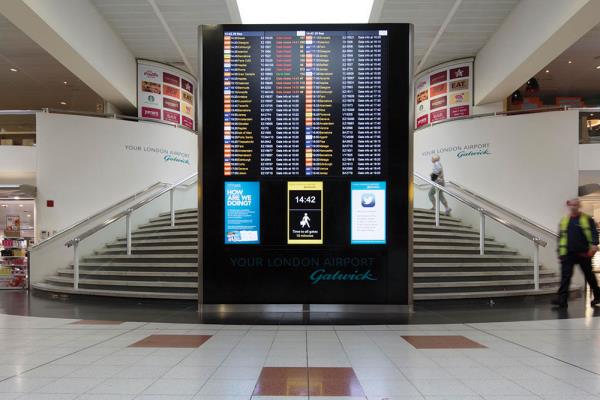07 March 2018

The airport’s 1,200 cloud-based screens now connect via a web browser from any operating system.
Gatwick is said to have become the world’s first major airport to introduce a cloud-based Flight Information Display System (FIDS).
While legacy FID systems require software to be loaded on a separate PC behind the screen to run them, Gatwick’s 1,200 cloud-based screens now connect via a web browser from any operating system.
It’s claimed this takes up only 3Mbps of bandwidth which makes the new real-time system “extremely” fast and responsive to updates, a key benefit in times of disruption.
The new VisionAir FIDS was developed by AirportLabs and went live in mid-2017.
The system can run natively on smart TVs which is said to save on infrastructure and maintenance costs. It is also said to offer flexibility and can be run from a mobile device without the need for any software installed.
Content can be managed collaboratively with other organisations, such as airlines and ground handlers, and different types of content can be hosted depending on requirements (disruption, weather, advertising, etc.).
Furthermore, unlike legacy FIDS, Gatwick says its new system is more robust to network blips or power failures with mobile battery power and 4G backup available if required. It also includes a fully independent management interface that supports operation completely independent from any airport infrastructure or system if required.
The system also has awareness of screen positions with respect to the airport layout and can target appropriate messaging depending on the situation, and can control backlighting to help reduce energy consumption where possible.
“The solution we now have in place is resilient, flexible and low cost with highly optimised data transfer,” says Gatwick CIO Cathal Corcoran. “We are transforming the way airport information is communicated and will soon allow passengers to interact with chatbots using Facebook Messenger, Whatsapp and other popular apps.”
Corcoran adds that Gatwick is also explor-ing the use of the IoT for improving situational awareness and machine learning for accurately predicting flight departure times. Last year, the airport also became the world’s first airport to deploy AR wayfinding (see online news at https://tinyurl.com/y7wwwxtj).










